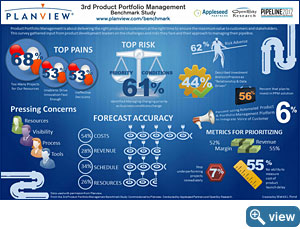Is it appropriate for product-based organizations to make improvised decisions when they don’t have visibility or access to proper data or metrics? Do product leaders have the resources for priority projects to drive innovation and growth? Is it possible that underperforming projects continue to consume precious resources? According to the industry’s third Product Portfolio Management Benchmark Study, the majority of product leaders struggle with these concepts and are eager to gain control of the innovation process in an economy that requires faster, smarter innovation with limited to no addition in resources.
A compilation of 320 product development executives and managers from around the world shared their priorities, risks, and pain points around product portfolio management (PPM) creating a sample size that allowed us to draw specific conclusions about the product development population. The following topics represent a snapshot of the study’s key findings. Download the full study methodology, demographics, additional results, findings, and recommendations.
Key Challenges
For the third time and by a wider margin this year, the top three pain points are:
- Too many projects for resources (68%)
- Not being able to drive innovation fast enough (53%)
- Decisions that go back and forth and get made late or ineffectively (56%)
These challenges affect one another and expose the fact that many organizations still do not have access or visibility to the data and consistent metrics needed to prioritize projects, drive innovation without adding resources, and ultimately drive winning products to market. Many organizations continue to report on the challenge to kill underperformers and properly allocate resources the highest value projects — these are just a few dilemmas facing product-focused companies today.
The Risks
Product executives from around the globe identified the following as the greatest risks when managing a product portfolio:
- Managing changing priorities as business conditions change (61%)
- Not cutting lower value projects that take away resources from more strategic projects (53%)
- Missing the voice of the customer and developing the wrong products (52%)
The results signify that there are serious challenges with data-driven decision-making because of the lack of data or the inability to access or synthesis it. Product leaders should consider how they currently approach portfolio scenario analysis and ideation management techniques. It’s crucial for these companies to maximize limited resources against the highest return (both strategic and profitable) projects and to ensure that in this day and age of multiple avenues to capture the customer voice that opportunities are not missed — thus the competition gains first mover advantage.
Prévisions
Participants were asked to rate their accuracy of forecasting in terms of Costs, Schedule, and Expected Revenue.
- Fifty-four percent rated their organization as accurately projecting costs
- More than one-third of participants rated themselves mostly inaccurate at projecting schedule
- Only twenty-eight percent rated their organization as being accurate at forecasting expected revenue
There are significant ramifications to business decision making over the usage of finite resources based on inaccurate forecasting information. While more than half were positive on the ability to project costs, only one-third are confident in revenue forecasts. The full report considers several questions as to why revenue projections are off: overzealous projections to get products approved; inaccurate average selling prices; or schedule impacts that negatively affect revenue performance? By having better ability to analyze scenarios, risk may be reduced.
Ressources
Nearly half of the respondents reported that they are somewhat poor to very poor in their ability to manage and forecast resource capacity accurately. With nearly 70% of participants stating that too many projects for their resources as their number one pain point, this is undoubtedly a key concern for organizations. The underlying challenge to effective resource capacity planning is projects that compete for the same resources and sales-driven “just do it” projects that are not on the product roadmap. The bottom-line here is that visibility and scenario analysis are paramount, or this trend will continue.
Systems
As we look at the trends in benchmarking the results since 2009, there is an increasing acknowledgment in the risk of relying on tools such as spreadsheets and project tools, which are unfit for the complex job of multi-product companies and their product portfolio management. The study shows that the use of Automated Product Portfolio Management Systems has doubled since 2010 and evaluation of PPM solutions expanded six-fold in the same period! It would be wise to consider how your competition is viewing the challenge and the opportunity. Could addressing PPM more effectively become a competitive differentiator?
Companies around the globe are recognizing the need to gain a tighter grip on the ins and outs of their product portfolios and gain visibility to make better business decisions to remain competitive. Companies require consistent processes, tools, and metrics to improve data availability, accuracy, and visibility. The full report goes into more recommendations and potential holistic or piecemeal approaches that companies may take to gain more control over their product pipelines and innovation plans.
Téléchargez la 3ème enquête de référence sur la gestion du portefeuille de produits réalisée en février 2012 par Appleseed Partners et OpenSky Research et commandée par Planview, Inc.
I’d like to hear from you. How does your organization compare to those who participated in the survey? What are your priorities, risks, and pains when it comes to innovation? Answer by leaving a comment below.





